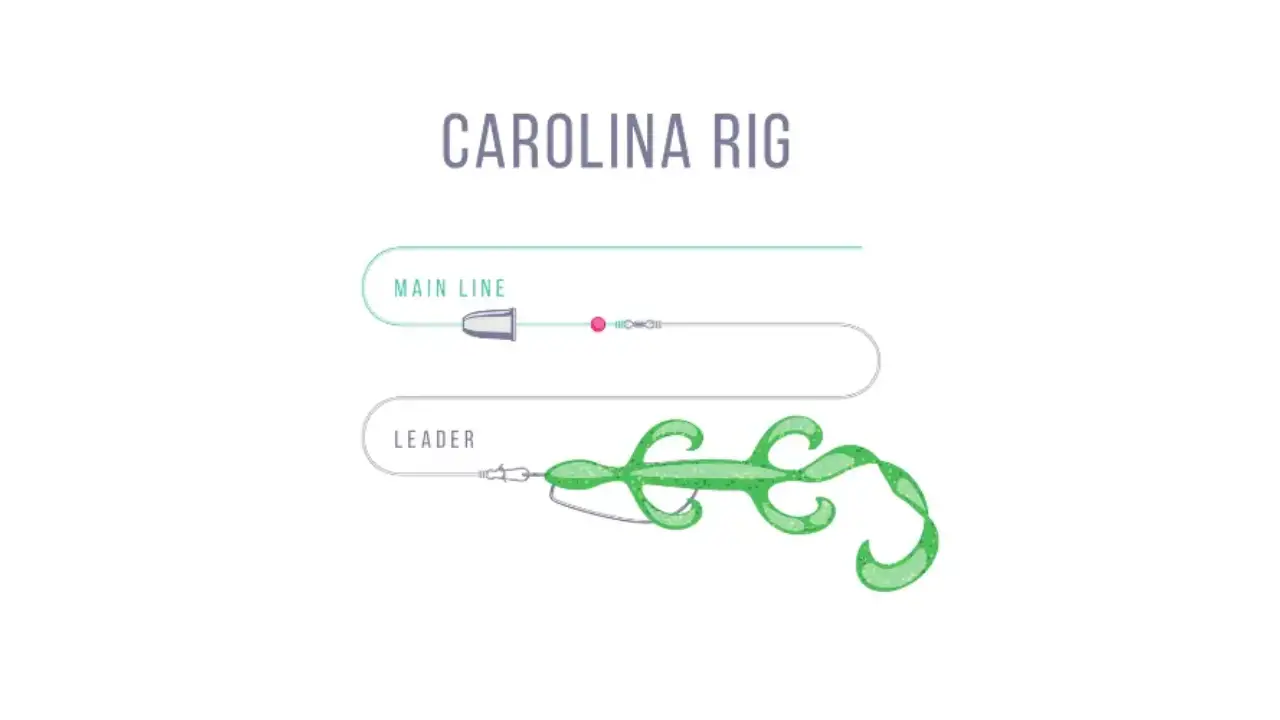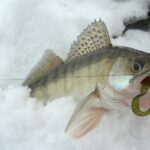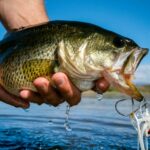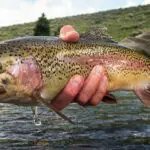When you start fishing regularly, you will likely hear all sorts of jargon being thrown around which can get quite overwhelming if you’re just a beginner.

For example, the Carolina rig and the Texas rig are both popular names in the fishing community but what are they exactly and how do you decide which one to use?
This article will fill you in on everything you need to know about the Carolina rig and the Texas rig including how to set them up and what to expect when fishing with them.
Once we have covered that we will begin to talk about how aspects such as the season and weather can have an impact on what rig you should use.
What Is A Carolina Rig?
The Carolina rig is one of the most popular choices of fishing rigs, especially when fishing for bass but it is also commonly used to fish for speckled trout, redfish, and flounder.
It is a plastic bait rig that uses a fixed weight separated from the lure with a leader which makes it move in a circular motion when the lure comes across a current or is dropped.
The circular motion of this rig is what appeals to the fish because it grabs its attention and looks appealing to attack. You are also able to drop the lure to get close to fish that are opportunists rather than waiting for them to close the distance.
This type of rig works best when you are using it slowly by either crawling it or moving it in between long pauses. Fish who are lethargic or more likely to sit down in the depths is what the Carolina rig is designed to target which is why it pays to be patient when you are using it.
The Carolina rig is great when you need to cover an area of water that is quite large in order to find fish and works on fish that are both lethargic and aggressive.
The Texas rig on the other hand is better when you are trying to catch a fish that is hiding in thick cover because the Carolina rig is likely to snag in such conditions.
How To Rig It Up
To rig up a Carolina rig, the first thing you need to do is thread the line through the sinker with bullet head sinkers being the best option for this as both the bead and the swivel will be easier to attach.
Once this is done, add the bead and slide it onto the line and into the sinker, then tie the knot and the swivel onto the line but make sure that it is not tied on so that it becomes restrictive and cannot get a lot of movement.

The reason for adding the bead is that it will act as a clacker which will attract fish such as bass and will also protect the knot from getting heavy weights knocked against it.
The leader line should be at least 12 to 18 inches long and remember that the longer the leader is, the more dynamic your floating bait will be which will make it look much more natural and enticing to fish.
On the end of this leader, use a strong knot such as a Palomar knot to tie a hook on, then put on some bait. The best lures to use with the Carolina rig are creature baits, plastic lizards, and skirted double-tail grubs.
Larger hooks should be used with larger baits, whereas smaller hooks should be paired with smaller lures. Keep in mind the type of species you’re after when deciding on hooking size as large hooks are not very effective against small fish and vice versa.
Fishing With A Carolina Rig
When fishing, Carolina rigs allow you to drag the lure along the bottom which gives you a feel of every nook and cranny with the bait slowly trailing behind.
By using longer casts, you can place the bait just out of the fish’s area so that you can make it come into view more naturally which is less likely to scare them off.
You can also wiggle the Carolina rig around a little bit to send movement through the bait if the water is too still or there is not enough activity happening on the bottom.
Fishing with a Carolina rig takes time to master but once you have learned how to use it, it will become second nature and will have much more fish in your icebox at the end of your fishing trips from now on.
What Is A Texas Rig?
Using a Texas rig is considered fairly old school compared to the Carolina rig as it has been around since the 1950s but is still quite popular.
Essentially, a Texas rig consists of a bullet-shaped weight that is not placed above the hook as it would be in a Caroline rig but is threaded onto the fishing line first which is then followed by a plastic or glass bead with a worm hook on the end.
An important thing to note about the Texas rig it is that it utilizes a plastic worm that must be placed on the line at a precise straight line.
The hook is then placed into the worm’s head and exits around 1/4 of an inch down its length. The worm is then rotated and dragged up the hook towards the shank, where it is now ‘locked’ on.
To make the rig weedless, the hook’s point is threaded back into the worm’s body.
The use of a bead is entirely optional.
Some anglers believe that the additional noise or color provided by a bead gives them an advantage in the stained or muddy water because the clicking imitates a crayfish crawling over rocks and debris, while others believe that the bead detracts from a realistic presentation because most worms do not click.
When presented to a specific target such as shallow foliage, flooded shrubs, or other sorts of cover, the Texas rig with its weight pressing up against the soft plastic lure is most effective.
It can also be used to entice lethargic fish to bite by slowly pushing the bait through the cover.
How To Rig It Up
When it comes to a Texas rig, one of the most crucial things you need to do is set up your rig correctly from the start. The way you fish with it after that will be determined by the sort of bait you use.
To set up at the Texas rig, the first thing you will have to do is tie the mainline to the micro-swivel with a uni knot which will help prevent the line from twisting when you retrieve it.

Once you have done this, tie the leader line onto the other end of the micro-swivel with another uni knot. Then, slide the bullet weight through the leader line followed by a fishing bead on the leader.
Use another uni knot to tie the hook to the end and use a soft plastic lure as bait.
Fishing With One
It’s simple to operate a Texas rig. That is why it is so popular with both novice and experienced anglers. Pick a position and cast your bait a little beyond it, according to our advice.
Allow the bait to sink for a few seconds before reeling it in until you receive a bite. Keep in mind that the retrieval should be slow in order to catch the attention of non-feeding fish.
One thing to keep in mind is that in order to use a Texas rig, you must first determine where the fish are, or else it will be much more difficult.
Plus, because it uses light sinkers that take too long to reach the bottom, this arrangement works better in shallow bodies of water.
Season
Some anglers are prone to using the same rig no matter the season but each rig comes with its own list of advantages and disadvantages when it comes to what season you are using it in.
In the spring, both the Caroline and Texas rigs are effective.
However, when fish such as bass migrate to and from their spawning locations the Carolina rig performs best as it can identify these fish faster than the Texas rig because the fish can be found anywhere along the migration route in depths ranging from 5 to 15 feet.
In the summer, both rigs function well, but in the fall, the Texas rig is usually the best performer. Bass are in the shallows all season pursuing baitfish and prefer fast-moving lures like crankbaits and spinnerbaits.
When cold fronts hit or fishing pressure forces bass into cover, a Texas rig is the best choice for catching lethargic fish.
As well as this, during Fall when bass fish are often in the shallow water, the Texas Rig will be more effective compared to the Carolina rig.
Weather
In strong sunlight, a Texas rig will catch some bass hugging the bottom and points, but a Carolina rig outperforms the Texas rig due to the setup’s heavyweight, which allows fishermen to make longer throws and cover more water.
The heavyweight also holds the bait closer to the bottom, and the lure on the leader line flows freely, giving it a more natural appearance. In deep open-water settings, a bigger weight on a Texas rig tends to restrict the action of the soft plastic bait, making it less effective.
Since bass tends to roam more in open water on cloudy, windy days a Carolina rig is the obvious choice for this type of weather.
Water Conditions
Water can move in many different ways and can vary in depth and clarity as well. These are among the things that you should take into consideration when deciding what rig to use as they could either work for you or against you.
In a body of water where there are strong currents, the Caroline rig will work better as it uses heavier sinkers and the current will make the rig look much more appealing and lifelike as the bait will move further away from the line.
The Texas Rig will perform significantly better in shallow waters. It’s lighter and less likely to sink into the depths.
When fishing for fish that prefer to live in deep waters, the Carolina rig is ideal because it is heavier than the Texas rig and will sink lower, reaching the fish that live in deeper water.
Conclusion
If you are serious about your fishing or are finding that you are not catching as many fish as those around you, it is worth paying attention to these details of when is best to use the Carolina rig and Texas rig.
Even though they are quite similar in appearance, you can get different results just by paying attention to the weather, season, and body of water that you are fishing in.
However, if you are a beginner or are only treating fishing as a past time, you likely won’t have to worry too much about these different rigs as one should start you off on the right foot either way and from there you can decide if you want to get more involved in the different equipment.
It’s good to remember that if you are using either a Carolina rig or a Texas rig, there is no wrong time to use them as this article is more about the best times to use them.
Go with whatever rig works best for you and you may even find that you are the opposite because technique and initiative also play a part in what rigs are most effective at what times.
- Do You Need An Indicator For Nymph Fishing? - November 16, 2023
- Fishing Safety Tips For Families - September 25, 2023
- What Is The Best Time To Night Fish At A Lake? - September 18, 2023









![Kayak Fishing for Beginners [10 Tips for a Successful Trip] fishing kayak moored on a beach](https://irvinelake.net/wp-content/uploads/2022/12/kayak-fishing-for-beginners-150x150.png)
